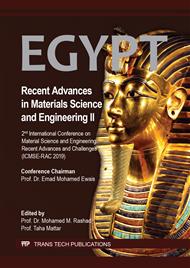p.141
p.149
p.155
p.163
p.171
p.178
p.186
p.193
p.200
Mechanical Properties of Thin Wall Ductile Iron: Experimental Correlation Using ANOVA and DOE
Abstract:
The present study was undertaken to investigate the effect of different metallurgical parameters such as casting techniques, wall thickness, inoculant technique, carbon equivalent, nodule count, ferrite and pearlite percent on the mechanical properties of thin wall ductile iron castings (TWDI). Understanding of the effect of chemistry, casting techniques, melting and molten treatment on the mechanical properties and microstructural features of TWDI castings would help in selecting conditions required to achieve optimum mechanical properties and alloy high strength to weight ratio. The use of the design of experiment (DOE) and the analysis of variance (ANOVA) can be a useful methodology to reach this objective. The analysis of the effects of each variable and their interaction on the mechanical properties of TWDI castings using green sand, green sand with insulation and investment casting techniques plays a key role in improved materials performance.The results indicate that nodule count, pearlite content and the interaction between carbon equivalent, nodule count and pearlite content have a significant effect on the tensile strength of TWDI castings. The impact toughness values decrease with smaller section thickness and increased nodule count. Using investment casting technique, decreasing the pearlite percent and nodule count, and increasing the wall thickness and ferrite percent reduce the values of ultimate tensile strength and yield strength. The results of percent elongation and impact toughness show a reverse trend compared with those of ultimate tensile strength and yield strength in terms with different metallurgical parameters.
Info:
Periodical:
Pages:
171-177
Citation:
Online since:
March 2020
Authors:
Price:
Сopyright:
© 2020 Trans Tech Publications Ltd. All Rights Reserved
Share:
Citation:


